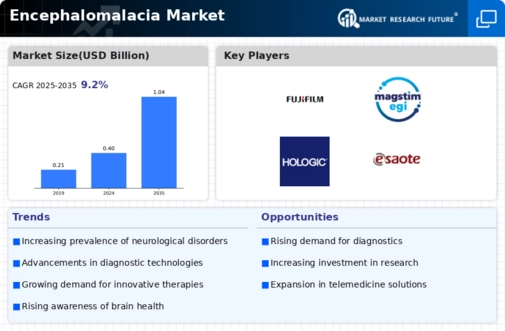Market Growth Projections
The Global Encephalomalacia Market Industry is projected to experience substantial growth over the next decade. The market value is anticipated to reach 1.04 USD Billion by 2035, with a compound annual growth rate of 9.09% from 2025 to 2035. This growth trajectory is influenced by various factors, including the increasing incidence of neurological disorders, advancements in diagnostic technologies, and rising awareness about encephalomalacia. The combination of these elements suggests a robust market environment, where stakeholders are likely to invest in research and development, leading to innovative solutions and improved patient care.
Emerging Therapeutic Options
The development of new therapeutic options for encephalomalacia is driving growth in the Global Encephalomalacia Market Industry. Innovative treatments, including neuroprotective agents and rehabilitation therapies, are being researched and introduced. These advancements aim to improve recovery outcomes for patients suffering from brain tissue damage. Clinical trials and studies are underway to evaluate the efficacy of these emerging therapies, which could lead to a broader acceptance and utilization in clinical practice. As these options become available, the market is expected to expand, reflecting the increasing demand for effective treatment solutions.
Growing Awareness and Education
There is a notable increase in awareness and education regarding neurological health, which is positively impacting the Global Encephalomalacia Market Industry. Public health campaigns and educational programs are informing individuals about the risks and symptoms associated with encephalomalacia. This heightened awareness encourages early medical consultation and intervention, which is essential for effective management of the condition. As a result, healthcare systems are likely to see an uptick in patient referrals and diagnoses, contributing to the market's growth. The anticipated compound annual growth rate of 9.09% from 2025 to 2035 underscores the potential for expansion in this sector.
Advancements in Diagnostic Technologies
Technological advancements in diagnostic imaging, such as MRI and CT scans, are enhancing the detection of encephalomalacia. These innovations allow for earlier and more accurate identification of brain tissue damage, which is crucial for timely intervention. As healthcare providers increasingly adopt these advanced imaging techniques, the Global Encephalomalacia Market Industry is likely to experience growth. The integration of artificial intelligence in imaging analysis further improves diagnostic accuracy, potentially leading to better patient outcomes. This trend aligns with the projected market growth, reaching 1.04 USD Billion by 2035, as more cases are diagnosed and treated effectively.
Increasing Incidence of Neurological Disorders
The rising prevalence of neurological disorders globally is a primary driver for the Global Encephalomalacia Market Industry. Conditions such as traumatic brain injuries and strokes, which can lead to encephalomalacia, are becoming more common. For instance, the World Health Organization indicates that stroke is the second leading cause of death worldwide. As the population ages, the incidence of these disorders is expected to rise, contributing to an estimated market value of 0.4 USD Billion in 2024. This trend suggests a growing need for effective diagnostic and therapeutic solutions, thereby expanding the Global Encephalomalacia Market Industry.
Rising Investment in Healthcare Infrastructure
Investment in healthcare infrastructure is a significant driver for the Global Encephalomalacia Market Industry. Governments and private sectors are increasingly allocating resources to enhance healthcare facilities, particularly in developing regions. Improved access to healthcare services, including specialized neurological care, is likely to facilitate early diagnosis and treatment of encephalomalacia. For example, initiatives to build advanced hospitals and clinics are underway in various countries, aiming to improve patient outcomes. This investment trend is expected to support market growth, as better healthcare infrastructure correlates with increased patient access to necessary diagnostic and therapeutic services.














